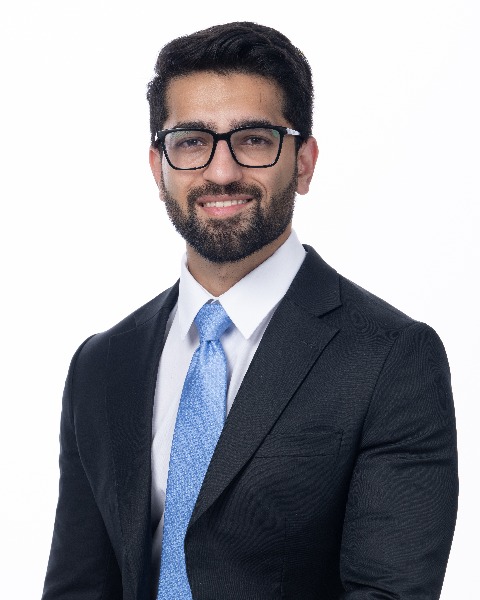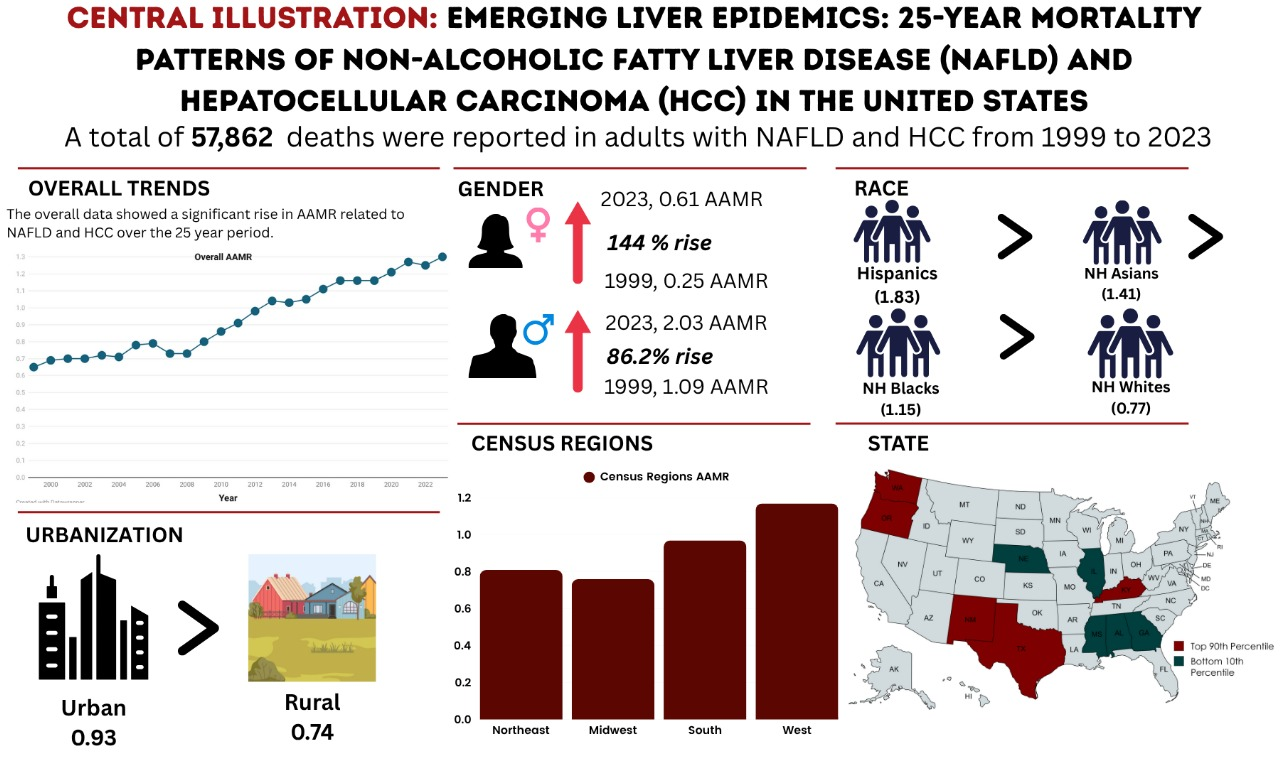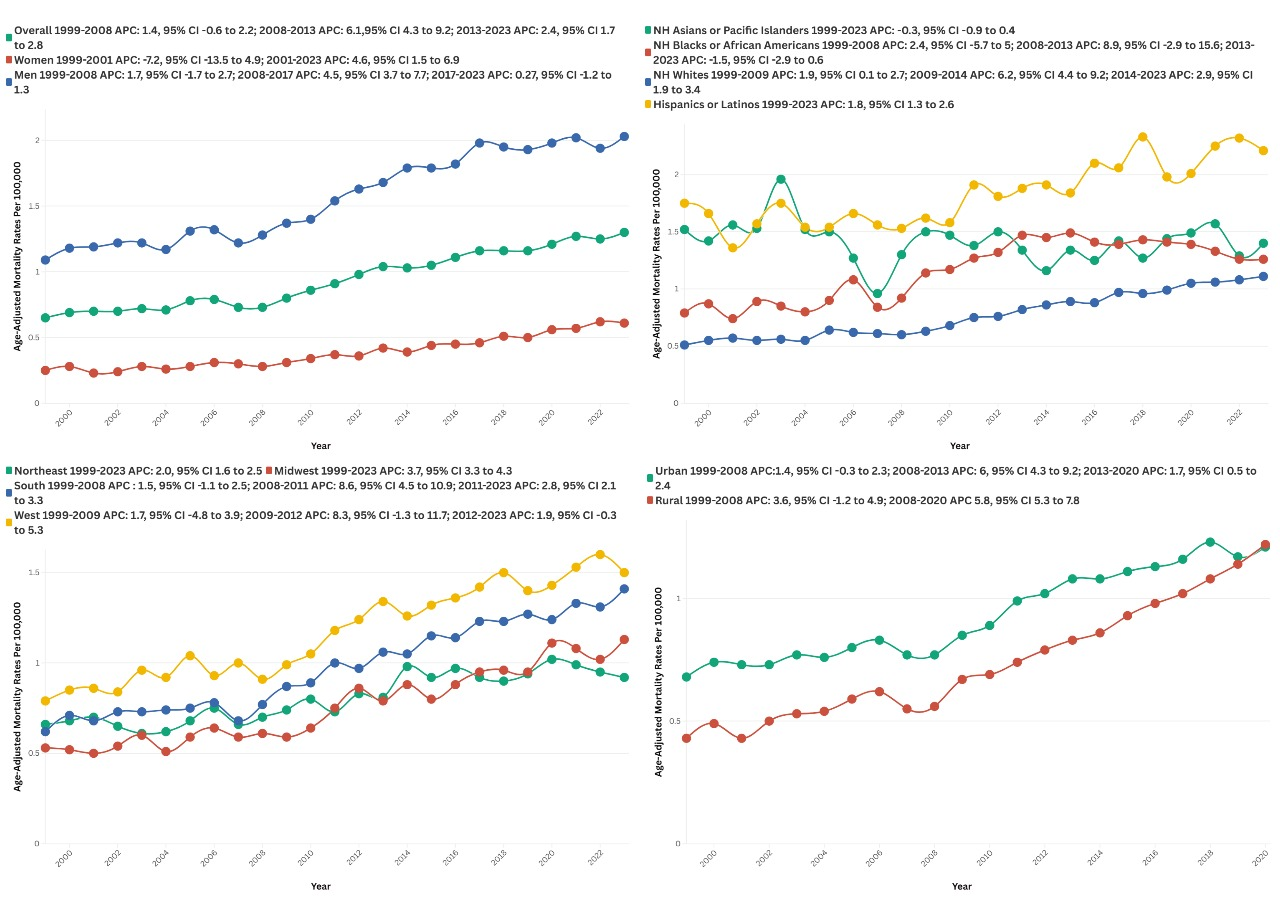Sunday Poster Session
Category: Liver
P1512 - Emerging Liver Epidemics: 25-Year Mortality Patterns of Non-Alcoholic Fatty Liver Disease (NAFLD) and Hepatocellular Carcinoma (HCC) in the United States
Sunday, October 26, 2025
3:30 PM - 7:00 PM PDT
Location: Exhibit Hall

Usman Bin Hameed, MD
Corewell Health William Beaumont University Hospital
Royal Oak, MI
Presenting Author(s)
Husnain Ahmad, MBBS1, Usman Bin Hameed, MD2, Muhammad Faizan Ali, MD3, Muhammad Hermain Amin, MBBS1, Aleena Sharif, MBBS4, Mujtaba Moazzam, MD2, Aagamjit Singh, MD5, Iman Ali, MBBS6, Sherif Eltawansy, MD7
1Shalamar Institute of Health Sciences, Lahore, Punjab, Pakistan; 2Corewell Health William Beaumont University Hospital, Royal Oak, MI; 3Jinnah Postgraduate Medical Centre, Karachi, Sindh, Pakistan; 4Sheikh Zayed Medical College Raheem Yar Khan, Bahawalpur, Punjab, Pakistan; 5William Beaumont Hospital, Royal Oak, MI; 6Shahida Islam Medical College, Bahawalpur, Punjab, Pakistan; 7Jersey Shore University Medical Center, Jersey Shore, NJ
Introduction: Nonalcoholic Fatty Liver Disease (NAFLD), the hepatic manifestation of metabolic syndrome, is strongly associated with obesity, insulin resistance, and type 2 diabetes. It has become a leading cause of chronic liver disease in the U.S. and a major risk factor for Hepatocellular Carcinoma (HCC), even in non-cirrhotic patients. As both conditions rise in prevalence, understanding mortality trends is essential for public health planning. This study analyzes long-term mortality trends and demographic disparities related to NAFLD and HCC in the U.S. from 1999 to 2023.
Methods: Mortality data were obtained from the CDC WONDER database using ICD-10 codes for NAFLD and HCC. Age-adjusted mortality rates (AAMRs) per 100,000 were calculated using the 2000 U.S. standard population. Joinpoint regression was used to estimate Annual Percent Change (APC) and Average Annual Percent Change (AAPC). Trends were assessed by sex, age, race/ethnicity, region, urban-rural status, and state. Significance was set at p < 0.05.
Results: From 1999 to 2023, 57,862 deaths were attributed to NAFLD and HCC. Inpatient facilities accounted for 42% of deaths; 35.5% occurred at home. The overall AAMR doubled from 0.65 to 1.30 (AAPC: 2.8; 95% CI: 2.5–3.0; p < 0.000001). Men had 310% higher AAMRs than women (1.56 vs 0.38), although women had a steeper increase (AAPC: 3.6 vs 2.4; both p < 0.000001). Adults aged 55–74 had the highest AAMR (2.4), but those ≥75 experienced the sharpest rise (AAPC: 4.4; 95% CI: 4.0–5.1). Young adults (25–54) showed a decline (AAPC: -2.6; p < 0.00001). Hispanics had the highest AAMR (1.83), while non-Hispanic Whites had the fastest growth (AAPC: 3.2; p < 0.000001). The West had the highest regional AAMR (1.17), and the Midwest saw the steepest rise (AAPC: 3.7). Urban AAMRs were higher than rural (0.93 vs 0.74), though rural areas had faster increases (AAPC: 4.4 vs 2.6). States in the top 90th percentile included Texas, Oregon, Washington, Kentucky, and New Mexico.
Discussion: NAFLD and HCC mortality rates in the U.S. have more than doubled over 25 years, with marked disparities by sex, age, race, and geography. Rising trends in women, elderly adults, and rural populations highlight a shift in disease burden. The steep increases among non-Hispanic Whites and in the Midwest signal emerging hotspots requiring targeted prevention and early detection strategies.

Figure: Overall trends, with stratification by gender, race, census region, state, and urbanization, in age-adjusted mortality rates (AAMR).

Figure: Line graphs illustrating trends in age-adjusted mortality rates (AAMR) for NAFLD-related HCC from 1999 to 2023, stratified by overall trends and subgroups including gender, race, census regions, and urbanization status.
Disclosures:
Husnain Ahmad indicated no relevant financial relationships.
Usman Bin Hameed indicated no relevant financial relationships.
Muhammad Faizan Ali indicated no relevant financial relationships.
Muhammad Hermain Amin indicated no relevant financial relationships.
Aleena Sharif indicated no relevant financial relationships.
Mujtaba Moazzam indicated no relevant financial relationships.
Aagamjit Singh indicated no relevant financial relationships.
Iman Ali indicated no relevant financial relationships.
Sherif Eltawansy indicated no relevant financial relationships.
Husnain Ahmad, MBBS1, Usman Bin Hameed, MD2, Muhammad Faizan Ali, MD3, Muhammad Hermain Amin, MBBS1, Aleena Sharif, MBBS4, Mujtaba Moazzam, MD2, Aagamjit Singh, MD5, Iman Ali, MBBS6, Sherif Eltawansy, MD7. P1512 - Emerging Liver Epidemics: 25-Year Mortality Patterns of Non-Alcoholic Fatty Liver Disease (NAFLD) and Hepatocellular Carcinoma (HCC) in the United States, ACG 2025 Annual Scientific Meeting Abstracts. Phoenix, AZ: American College of Gastroenterology.
1Shalamar Institute of Health Sciences, Lahore, Punjab, Pakistan; 2Corewell Health William Beaumont University Hospital, Royal Oak, MI; 3Jinnah Postgraduate Medical Centre, Karachi, Sindh, Pakistan; 4Sheikh Zayed Medical College Raheem Yar Khan, Bahawalpur, Punjab, Pakistan; 5William Beaumont Hospital, Royal Oak, MI; 6Shahida Islam Medical College, Bahawalpur, Punjab, Pakistan; 7Jersey Shore University Medical Center, Jersey Shore, NJ
Introduction: Nonalcoholic Fatty Liver Disease (NAFLD), the hepatic manifestation of metabolic syndrome, is strongly associated with obesity, insulin resistance, and type 2 diabetes. It has become a leading cause of chronic liver disease in the U.S. and a major risk factor for Hepatocellular Carcinoma (HCC), even in non-cirrhotic patients. As both conditions rise in prevalence, understanding mortality trends is essential for public health planning. This study analyzes long-term mortality trends and demographic disparities related to NAFLD and HCC in the U.S. from 1999 to 2023.
Methods: Mortality data were obtained from the CDC WONDER database using ICD-10 codes for NAFLD and HCC. Age-adjusted mortality rates (AAMRs) per 100,000 were calculated using the 2000 U.S. standard population. Joinpoint regression was used to estimate Annual Percent Change (APC) and Average Annual Percent Change (AAPC). Trends were assessed by sex, age, race/ethnicity, region, urban-rural status, and state. Significance was set at p < 0.05.
Results: From 1999 to 2023, 57,862 deaths were attributed to NAFLD and HCC. Inpatient facilities accounted for 42% of deaths; 35.5% occurred at home. The overall AAMR doubled from 0.65 to 1.30 (AAPC: 2.8; 95% CI: 2.5–3.0; p < 0.000001). Men had 310% higher AAMRs than women (1.56 vs 0.38), although women had a steeper increase (AAPC: 3.6 vs 2.4; both p < 0.000001). Adults aged 55–74 had the highest AAMR (2.4), but those ≥75 experienced the sharpest rise (AAPC: 4.4; 95% CI: 4.0–5.1). Young adults (25–54) showed a decline (AAPC: -2.6; p < 0.00001). Hispanics had the highest AAMR (1.83), while non-Hispanic Whites had the fastest growth (AAPC: 3.2; p < 0.000001). The West had the highest regional AAMR (1.17), and the Midwest saw the steepest rise (AAPC: 3.7). Urban AAMRs were higher than rural (0.93 vs 0.74), though rural areas had faster increases (AAPC: 4.4 vs 2.6). States in the top 90th percentile included Texas, Oregon, Washington, Kentucky, and New Mexico.
Discussion: NAFLD and HCC mortality rates in the U.S. have more than doubled over 25 years, with marked disparities by sex, age, race, and geography. Rising trends in women, elderly adults, and rural populations highlight a shift in disease burden. The steep increases among non-Hispanic Whites and in the Midwest signal emerging hotspots requiring targeted prevention and early detection strategies.

Figure: Overall trends, with stratification by gender, race, census region, state, and urbanization, in age-adjusted mortality rates (AAMR).

Figure: Line graphs illustrating trends in age-adjusted mortality rates (AAMR) for NAFLD-related HCC from 1999 to 2023, stratified by overall trends and subgroups including gender, race, census regions, and urbanization status.
Disclosures:
Husnain Ahmad indicated no relevant financial relationships.
Usman Bin Hameed indicated no relevant financial relationships.
Muhammad Faizan Ali indicated no relevant financial relationships.
Muhammad Hermain Amin indicated no relevant financial relationships.
Aleena Sharif indicated no relevant financial relationships.
Mujtaba Moazzam indicated no relevant financial relationships.
Aagamjit Singh indicated no relevant financial relationships.
Iman Ali indicated no relevant financial relationships.
Sherif Eltawansy indicated no relevant financial relationships.
Husnain Ahmad, MBBS1, Usman Bin Hameed, MD2, Muhammad Faizan Ali, MD3, Muhammad Hermain Amin, MBBS1, Aleena Sharif, MBBS4, Mujtaba Moazzam, MD2, Aagamjit Singh, MD5, Iman Ali, MBBS6, Sherif Eltawansy, MD7. P1512 - Emerging Liver Epidemics: 25-Year Mortality Patterns of Non-Alcoholic Fatty Liver Disease (NAFLD) and Hepatocellular Carcinoma (HCC) in the United States, ACG 2025 Annual Scientific Meeting Abstracts. Phoenix, AZ: American College of Gastroenterology.
